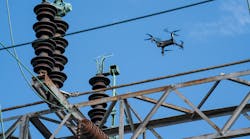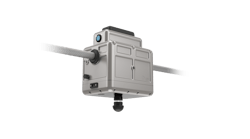After almost 25 years of service, the generator and transformer protection systems at the hydropower plant of a Western U.S. dam and reservoir were upgraded, including the replacement of electromechanical relays with microprocessor- based relays from Schweitzer Engineering Laboratories, Inc. (SEL), Pullman, Washington.
Originally designed for flood control on a major river, the multipurpose project now also provides irrigation water to a major agricultural area, enhances water quality, supplies domestic and industrial water, enhances fish and wildlife habitat, creates recreational opportunities, and generates electric power.
Hydropower, such as that produced at this project, provides stability to the power grid and helps avoid outages due to the loss of a base-load power plant. This reserve hydropower, which can be brought online within a few minutes, provides standby electric generation that keeps the power grid stable. Such plants help compensate for fluctuating power generation and transmission flows that occur during emergencies.
The dam is an earth-and-rock-fill structure, more than 600 feet high and 1500 feet wide at the crest. Located above ground at the dam site, the power plant houses two 150 MW turbine hydrogenerators, which produce more than 360 million kilowatt-hours of electricity. The power generated at this peaking plant supports the requirements of the nearby area, with remaining energy marketed through the grid to customers located outside the area.
Major components of the upgrade project include two SEL-387E Relays installed for comprehensive protection, metering, and event reporting of the power plant transformers. Generator protection is provided by two SEL-300G Generator Relays, which also provide important metering and events reporting/recording capabilities plus thermal protection in conjunction with RTDs.
Historically, the system used analog transducers (12 per hydrogenerator) to convert RTD measurements into scaled analog quantities. These transducers required annual calibration, using considerable technician time in the process. Due to maintenance requirements and some heating issues on one generator, a more economical and reliable RTD technology was considered. The initial approach was to take advantage of the capability of acquiring and transmitting temperature data with an SEL-2600A RTD Module.“The customer chose the SEL-2600A RTD Module because it requires no annual calibration or maintenance and resulting simplification of RTD wiring. A single fiber-optic interconnection between the SEL-2600A and SEL-300G Relay provides all needed temperature data for the alarm and protection capabilities within the SEL-300G Relay,” said Greg Rauch, SEL application engineer.
They had heating issues with one of the hydrogenerators. Up until the SEL relay installation, they only had alarm and protection functions on one RTD for each generator. The customer later found that the RTD used for this purpose was not located at the hot spot of the generator. The hot spot was located at the endcaps of the generator stator winding, and the heat radiated toward the RTDs located above. There were no data gathering capabilities with the relay-connected RTD, so they had no information as to what was happening with the RTD. The customer considered changing the RTD being monitored by the existing relay, but decided, instead, to install the SEL technology, which can give alarms and tripping on all RTDs simultaneously,” Rauch said.
The original SEL-2600 RTD Module was installed and tested. However, the RTD-connecting cables were not shielded, and the existing RTDs have a much lower signal-to-noise ratio tolerance; therefore, the module could not overcome the noise from the RTD wiring while the generator was under load.
To deal with the noise problem, SEL developed a new RTD module, the SEL-2600A. Designed for use with transformers, generators, electric motors, and other power system apparatus, the SEL-2600A operates with four types of RTD inputs, including 100-ohm platinum, 100-ohm nickel, 120-ohm nickel, and 10-ohm copper. The SEL-2600A is a fully compatible replacement for the SEL-2600 and provides new-generation, patentpending noise rejection technology. Fiberoptic links eliminate expensive cable pulls and provide electrical noise immunity and ground isolation between devices.
“We redesigned our standard SEL-2600 RTD Module and launched a new product to handle all types of situations,” says Rauch. Using this process, “We’ve made the product compatible with all common RTD types used in many applications. It also works well for upgrading older installations that use the 10-ohm copper technology.”
Another benefit of the installation is that a single fiber-optic strand runs to the control room where the generator protection relay is located and handles data that come from the SEL-2600A. “This eliminates several control wires, which are susceptible to electromagnetic interference and other noise sources. Because this product eliminates the use of transducers altogether, it frees additional space in cable trays and wiring junction boxes,” added Rauch.
The SEL-2600A temperature monitoring scheme at the dam and power plant is used for alarm and trip functions in each SEL-300G. Temperature data are passed to the plant data control system via Modbus
communications from the SEL-300G to the plant remote terminal unit. Stator temperature data are available locally and at the main control center located more than 60 miles away.To date, the new power plant protection system is operational and error free. Thermal data are now transmitted from 12 different RTDs in each hydrogenerator. The RTDs are virtually maintenance free, which frees up technical support personnel. The project engineer felt that the project was a highly worthwhile experience. “I was very entrenched in the entire upgrade project, but enjoyed tackling the generator heat monitoring problem in a creative way that made a lot of sense,” he said.
The SEL-2600A is compatible with several SEL devices, including the SEL-701 and SEL-749M Motor Protection Relays. It may also be used with SEL fiber-optic transceivers to connect the SEL-387, the SEL-300G, the SEL-421 and SEL-451 Protection, Automation and Control Systems, and the SEL-2032 and SEL-2030 Communications Processors.

